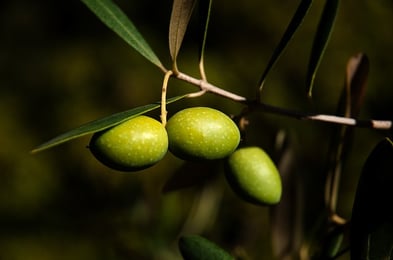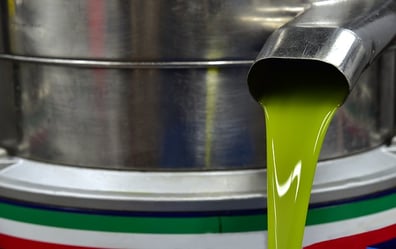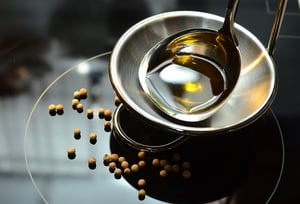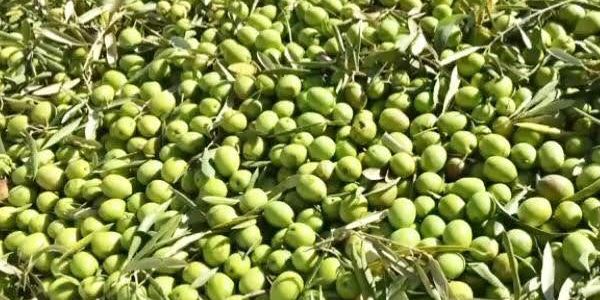Listen to this article
When a new olive oil campaign is about to begin, most producers and master millers have a very clear goal: to bring the best Extra Virgin Olive Oil (EVOO) to the market. To achieve this result, there cannot be any failures within the elaboration process.
The excellent Extra Virgin Olive Oil preparation does not respond to an exact mathematical formula. We are talking about living matter.
“Only a deep knowledge of your raw material and the olive oil elaboration process will make your objective possible.”
The oil mill is the starting point where the olive is received and where the transformation begins. The machinery intervenes as a protagonist in the transformation and processing phases: washing, grinding, blending, decanting, filtering and, finally, storing in the cellar.
Seen in this way, the process almost looks like a closed circuit in which exhaustive control and good machinery will give the desired result, but you know that it is not that simple.
A quality fruit picked at the right moment in the right way, that reaches the hoppers in optimal conditions and goes through the different phases under an exhaustive control, gathers the controllable characteristics to achieve the final objective. But, as we have already commented, this is not an exact science.
Unforeseen factors will for sure appear along the process. We will then need to do our best, to get our learnt resources to tackle these problems properly, thus obtaining the type of oil that you are looking for. A good training will be crucial at this point.
How to identify, limit and solve those problems that appear at the most unexpected moments? How to understand what is happening? How can I know which is the best solution solution in each case?
1. The olive arrives, everything starts
The oil mill process begins when the olive reaches the mill from a healthy olive grove. The Mill is wide and easily accessible in both directions, allowing simultaneous entry and exit of vehicles, thus speeding up the first phase with the arrival of olives to the hoppers from where they will be evacuated to the washing area and cleaning.

Let's review the theory of how olive oil is made: upon passing the hoppers, the olive faces a first step that is divided into three phases: cleaner, destemmer and washing machine. The objective is to make the fruit as free of impurities as possible, to lose the litter that it could bring, the possible remains of mud and chopsticks.
This phase is very important because, from the very beginning of the process, your oil can follow the path towards quality or get lost among the lampante oils that move in the market. Water is the secret.
You should use clean water in its proper measure. Do not use it in excess, since this will bring you: unnecessary expenses, a harmful waste to the environment, and a possible appear of defect in the oil, which will be unrecoverable.
2. Grinding and its dependence on variability requires training
The terrain is affected by constantly changing factors. The variability of the product reaches such an extreme that, as you probably know, the olive can show changes in its constitution in terms of water, oil and pulp, from one day to the next. Yes, even if it is the same variety and fruits collected in the same area of the olive grove.
How to detect those changes that can difficult the extraction process, probably the most important phase of all?
The first thing is to know the grinding thoroughly, to understand that:
both the composition of the oil and the amount of volatiles and the organoleptic characteristics are directly determined by the type of grinding that is carried out.
Taking into consideration that the composition of the fruit can vary, you have the range, with bounded acceptable margins, between which you can move the values in an orientative way. In the case of oil we talk about between 15 and 25 per cent; in the case of vegetation water, between 40 and 60 per cent, and in the case of bone and plant tissue, we would talk about between 20 and 35 per cent.
This information is very important for the process of obtaining olive paste, but the ranges are wide and the process can make the variables take unwanted paths.
For example, if the quality of the oil falls during the first phase during grinding, what would it be necessary to modify? Probably this decrease in the paste is due to an error in the grinding speed.
And if the speed is correct, why has there been a loss of aromas or alterations in the colour and flavour of the olive paste?
Grinding is the master key to enter the process that can lead you to reach your goal but for that, you need to discover, interpret and clear the unknowns that are presented to you to know why and how to act if, for example, you have obtained a difficult paste.
3.- The purpose of malaxation
The purpose of malaxation is to gradually join the small drops of oil into larger drops. It is very important to avoid over-blending, as this will cause an emulsion to form between the oil and the paste.
The paste is inserted into the stainless steel malaxer at a temperature that ranges between 25º C and 35º C. However, the optimal temperature for quality EVOO is around 23º C.
Along with temperature, the two other key factors are the malaxing speed and the length of time. In general, malaxing should not exceed 30 minutes for high quality EVOO.
It is also useful to be familiar with the tools available for helping you achieve high quality EVOO. These tools are exclusively physical in nature.
For example we have talcum powder. This adjuvant has been permitted since 1986. It is used in many mills as it increases the yield yet produces no alteration in the quality of the oil.
4.- To deal with difficult pastes you need reinforcements
The continuous oil phase that occurs during malaxation is particularly important because it combines two contradictory tendencies: on the one hand, we want to obtain quality EVOO of course, but on the other, we also want the highest level of extraction, i.e. the most efficient depletion of the pomace possible.
Finding that balance is not a simple task: you will need experience and training, which only come with hard work and patience. In your attempt to make high quality EVOO you may follow the popular trend of harvesting early. This is a risky bet that can bring with it the complication of producing difficult or emulsified pastes. How can you avoid this? Don't worry, just know that you will need reinforcements, for example in the form of training.
A first step is to carry out an exhaustive visual control, and here your experience will guide you. However, you will inevitably miss details because there will be things that you still do not know--visual signs that tell us that something is not going right.
We may see, for example, paste that looks grainy and is darker than in the first stage of malaxation, or there might be cracks in the paste that might indicate a lack of moisture. These are signs that we need to intervene to correct this issues that can ultimately spoil the process.
5.- The decanter moves into action
The process continues and a new protagonist enters the scene: the decanter. The decanter separates the oil from the olive paste.
The olive paste must be fed in a homogeneous and steady way to optimize this stage.
After the paste has been correctly malaxed and the visual control indicates that the process is functioning properly, it is injected into the decanter with a device that allows us to rectify the moisture of the paste if necessary, which will allow us to maintain a good depletion level, thus maintaining a proper balance between maximum extraction and high quality.
In this phase, monitoring the paste pump and performing proper maintenance of the stators can make the difference between obtaining the EVOO you are looking for and that you are on your way to getting, or being stranded in the process.
This phase is very important for the degree of clarification of the oil, and is directly related to the diameter of the diaphragms, and the overflows of the decanter. If these phases are correctly carried out, the oil will come out clear and clean. The process is progressing very well.
6.- Washing and polishing the oil: the vertical centrifuge
The vertical centrifuge is a very important phase and is undoubtedly necessary to produce high quality EVOO. With this phase, we can obtain a very clean oil. In the vertical centrifuge, the solids are separated out and the water is expelled. Now the clean EVOO is ready for decantation and storage. This is a delicate moment where the addition of water and temperature adjustment play a major role which must have very clear objectives since a small error could lead to more aggressive oxidation and, consequently, to a loss of quality.
Regulating the vertical centrifuge discharge is very similar to that of the decanter. The diaphragm again plays a leading role here and learning to use the proper size will make the difference between a clean oil, a dirty oil, or a watery oil. Again: balance is the key.

If the cleaning process has been correctly carried out, the EVOO will come out of the centrifuge slightly cloudy due to the level of humidity and the occluded air--nothing that a little decantation can't solve, assuming the other steps have been carried out properly.
Regarding centrifuges, it is essential to understand something that will affect the final result of your EVOO: for the centrifuge to operate correctly it is absolutely necessary to make sure it has been thoroughly cleaned. It needs to be subjected to either a ZIP type cleaning, while the centrifuge is running, or total cleaning, with the centrifuge stopped, at the end of the season.
7.- Trust me, filtering never goes out of style
In recent years, the word 'artisanal' has been used as a synonym for pure, clean, no external manipulations, etc. And yes, there are products that can fall into this category. However, this is not the case with EVOO.
Not filtering-- with the aim of offering a more natural, less industrial oil --is a mistake that can cost you your mill's reputation. I trust this will not be your case. Filtering is done to eliminate the majority of moisture and impurities that may still be in the oil. This is the final step to stabilize the oil before storage.

Filtering is a process that is carried out with the aim of eliminating most of the moisture and impurities that may still be in the oil, is to take the definitive step towards storage and stabilization.
The different filters available on the market, such as cellulose plates or diatomaceous earth, each have their pros and cons, but with the proper training there will be no mystery to filtering and you can now top off the entire process of high EVOO production, the last step before storage and packaging.
8.- Storage
EVOO that is stored in the best conditions will remain intact for the necessary amount of time.
An oil stored in appropriate tanks, at a stable temperature, away from light and within a proper time frame retains its good qualities. It may even be possible, if you have the right tools and knowledge, to correct the acidity and the parameters of quality before moving the oil to the bodega.
And once in the cellar, how can we preserve and protect our EVOO? For starters, we can create a space designed to avoid factors that contribute to the degradation of EVOO such as oxygen, light, unstable temperature, the use of certain harmful metals, or the passage of time, which never works in favor of an extra virgin olive oil.
You have surely designed your oil mill already, or you have found what you consider the right place for the bodega. Spare no expense: the road to success in this last stage is intense and at times difficult, but the EVOO you get will make it worth the effort.
Technological progress has given us resources that just a few years ago would have been unimaginable. Our advice is that you squeeze all you can out of these tools with the same care and the same professionalism that you put into your olive grove to ensure the maximum quality of yor EVOO and obtain all its benefits.
Do not overlook proper training: it will be your best ally for extracting every last drop of high quality EVOO. It will make a big difference.
.png)


